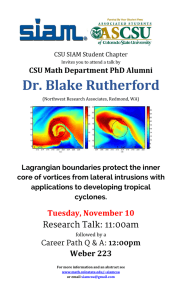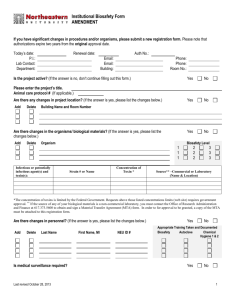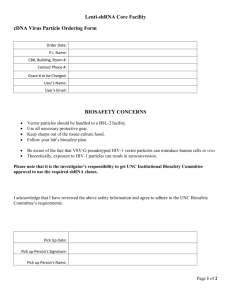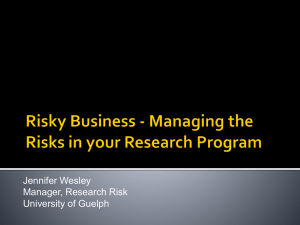Pod 4 GMP/Product Development BSL‐3 Emergency Response Packet TAKE THIS PACKET WITH YOU!
advertisement
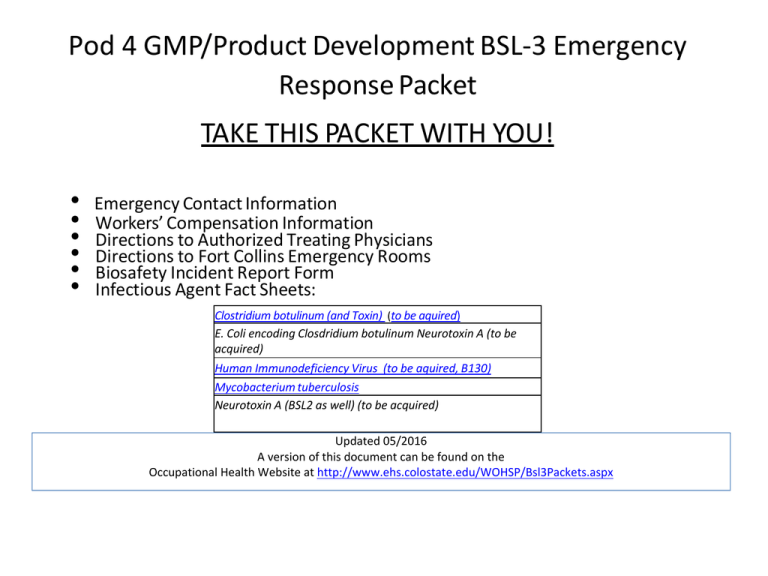
Pod 4 GMP/Product Development BSL‐3 Emergency Response Packet TAKE THIS PACKET WITH YOU! • • • • • • Emergency Contact Information Workers’ Compensation Information Directions to Authorized Treating Physicians Directions to Fort Collins Emergency Rooms Biosafety Incident Report Form Infectious Agent Fact Sheets: Clostridium botulinum (and Toxin) (to be aquired) E. Coli encoding Closdridium botulinum Neurotoxin A (to be acquired) Human Immunodeficiency Virus (to be aquired, B130) Mycobacterium tuberculosis Neurotoxin A (BSL2 as well) (to be acquired) Updated 05/2016 A version of this document can be found on the Occupational Health Website at http://www.ehs.colostate.edu/WOHSP/Bsl3Packets.aspx EMERGENCY PHONE NUMBERS BIOSAFETY EMERGENCY NUMBER 970‐491‐0270 IDRC On‐Call 491‐IDRC (491‐4372) Fort Collins Emergency Room 970‐495‐7000 Occupational Health Coordinator 970‐ 420‐8172 Workers’ Compensation Procedure Updated 5/2016 NOTE: Workers Compensation Statutes change frequently, and every effort has been made to update this document accordingly. However, Risk Management is the source for the most current Workers’ Compensation procedures: http://rmi.prep.colostate.edu/workers‐compensation • Report Injury or exposure as soon as possible – • Medical attention, if sought, must be sought by a CSU Authorized Treating Physician – • • Online link: required forms: Worker's Compensation Report Click here for a complete list of CSU Authorized Treating Physicians ‐ Listed by County All claims are subject to review and may not be covered under Workers Compensation unless found compensable under current Worker’s Compensation Statutes. – GO TO A CSU AUTHORIZED TREATING PHYSICIAN WHENEVER POSSIBLE as initial visit costs will be covered through Workers Compensation even if it is determined that your illness is not work related. If you must go to the ER or an Urgent Care provider for the specific reasons listed above, you and/or your insurance carrier will be responsible for all health care costs for illnesses/injuries that are NOT related to your employment. – However, in order to assure that medical attention is sought when needed for BSL3 infectious disease exposures, please communicate with CSU’s Workers Compensation Manager (970)491‐ 4832 for consideration to be covered under Workers’ Compensation when medical attention is sought in compliance with CSU’s Emergency response protocols. Contact CSU’s Occupational Health Program Coordinator, Joni Van Sickle for assistance with this process (970) 420‐8172, joni.triantis@colostate.edu. CSU Workers’ Compensation Website: http://rmi.prep.colostate.edu/workers‐compensation When to go to a CSU Authorized Treating Physician • During regular business hours • When you have a fever, and you have been in the BSL‐3 barrier in the last 5 days • When you have a KNOWN exposure to or an injury INVOLVING TUBERCULOSIS • When you have a minor injury • When told by the ER, Urgent Care, or Workers’ Compensation to follow up after an Emergency Room or Urgent Care visit • Due to limitations in Workers’ Compensation coverage for ER or Urgent Care visits, see a CSU Authorized Treating Physician whenever possible. • For details see Workers’ Compensation Procedure in this packet, or click here for online http://www.ehs.colostate.edu/WOHSP/Illness_Policy_Info_Emergency_Response_Packets/Current_General_BSL3_Biosafe ty_Incident_Information.pdf CSU AUTHORIZED TREATING PHYSICIANS For NON‐EMERGENCY incidents If you go to the Emergency Room, follow‐up with one of these providers A complete list of designated providers can be found at: http://rmi.prep.colostate.edu/workers‐compensation/atp/ FROM FOOTHILLS CAMPUS: • Right on Overland trail • Left on W. Prospect Rd • Left on S. College Ave. • Left on Harmony Rd. • Right on Snow Mesa Dr • Occ Health is on 2nd floor, Suite 200 Approximate drive time is 20 minutes. FROM MAIN AND SOUTH CAMPUSES: • South on College Ave. • Left on Harmony Rd. • Right on Snow Mesa Dr • Occupational HHealth Services is on 2nd floor, Suite 200 Approximate drive time is 15 minutes. University of Colorado Health Occupational Health Services 4674 Snow Mesa Drive, Suite 200 Fort Collins, CO (970) 495‐8450 Mon‐Fri, 7:00am ‐ 6:00pm FROM FOOTHILLS CAMPUS to Workwell, Fort Collins • Turn Right on Overland Trail. • Turn Left on W. Prospect Road. • Turn Right at Specht Point Drive. • Workwell is located on the first floor. Workwell Fort Collins 1600 Specht Point Road, Suite 115 Fort Collins, CO (970) 672‐5100 Mon‐ Fri, 8:00am ‐ 5:00pm Workwell Loveland 1608 Topaz Drive Loveland, CO (970) 593‐0125 Mon‐Fri, 8:00am ‐ 5:00pm Approximate drive time is 15 minutes. FROM MAIN AND SOUTH CAMPUSES to Workwell, Fort Collins • Head East on Prospect Road. • Turn Right at Specht Point Drive. • Workwell is located on the first floor. Approximate drive time is 15 minutes. When to go to the Emergency Room • When you have a KNOWN EXPOSURE to a BSL‐3 infectious agent (other than Tuberculosis) • When you have a major injury • WHEN A CSU AUTHORIZED TREATING PROVIDER IS CLOSED and you have a fever within 5 days of being in the BSL‐3 barrier and/or have symptoms associated with disease due to pathogens worked with. – IF YOU GO TO THE EMERGENCY ROOM OR URGENT CARE AND ARE DIRECTED TO DO SO, YOU MUST FOLLOW UP WITH ONE OF THE CSU AUTHORIZED TREATING PHYSICIAN THE NEXT BUSINESS DAY. • Complete list: http://rmi.prep.colostate.edu/workers‐compensation/atp/ • If you go to the Emergency Room or Urgent Care, it is your responsibility to follow up by providing them with your Workers’ Compensation claim number and billing information: P.O. Box 4998 Greenwood Village, CO 80155 Phone: (303) 804‐2000 Fax: (303) 804‐2005 Toll‐Free: (888) 428‐4671 Emergency Room Directions Please do not drive yourself. Have someone take you. Contact Biosafety if you need a ride. 970 491‐0270 EMERGENCY ROOM NEAREST TO CSU Go to Emergency Room closest to you Poudre Valley Hospital Emergency Dept (Colorado Health Medical Group) 1024 South Lemay Ave Fort Collins, CO (970) 495‐7000 24 hours, 7 days per week FROM FOOTHILLS CAMPUS • Turn Left on Overland Trail • Turn Right on W. Mulberry Street • Turn Right on Riverside Avenue • Turn Right at S. Lemay Avenue • Hospital is on the East side of the road. Approximate drive time is 15 minutes. FROM MAIN AND SOUTH CAMPUSES • Head East on Prospect or Drake • Turn Left at Lemay Avenue • Hospital is on the East side of the road. Approximate drive time is 10 minutes. Poudre Valley Hospital Harmony URGENT CARE Go to an Urgent Care closest to you FROM FOOTHILLS CAMPUS • Turn Left on Overland Trail • Turn Right on Mulberry Ave • Turn Right on Riverside Ave • Turn Left on E. Prospect Rd • Turn Right on Timberline Rd • Turn Left on E. Harmony Rd • Facility is on the South side of Harmony Road • Follow signs to Urgent Care Approximate drive time is 21 minutes FROM MAIN AND SOUTH CAMPUSES • Head East on Prospect Rd • Turn Right on Timberline Rd • Turn Left on E. Harmony Rd • Facility is on the South side of Harmony Road • Follow signs to Urgent Care Approximate drive time is 20 minutes PVHs Harmony Urgent Care 2127 E. Harmony Road Daily, 8 a.m. to 8 p.m. (970) 297‐6250 Incident Report Form THIS IS NOT A WORKER’S COMPENSATION REPORT If this is an injury, have you filled out a workers’ compensation form? □ Yes □ No Personal Information Date: CSU ID: First Name: Last Name: Email: Phone Number: Alt. Phone Number: Emergency Contact Information Name: Name: Phone #: Phone #: Alt. Phone #: Alt. Phone #: Incident Information Pathogen working with: Does the pathogen contain recombinant DNA or synthetic nucleic acid molecules? Location (building, room): Yes No Time of Incident: Incident Type (exposure, physical injury, etc.): Incident Description (Provide as much detail as possible and list external events that may have contributed to the incident): Method and Location of Injury (check all that apply): Method Needlestick Blood or body fluids Spill Location Aerosol Animal Bite/Scratch Necropsy Broken glass Sharps Container Other (descirbe) Action(s) taken to control incident (e.g. hand washing, spill clean‐up, etc.): Personal Protective Equipment (PPE) Worn at time of Injury Scrubs Surgical gown N‐95 respirator mask Gloves Hair Cover □ Tyvek □ PAPR □ Face Shield □ Goggles □ Shoes Was there a PPE failure? If yes, explain: Print or scan and send to the Biosafety Office: 1690 Campus Delivery, Fort Collins, CO 80523‐1690; E‐mail scanned copies to Heather.Blair@colostate.edu Botulinum toxin, Botulinum Toxin Producing Clostrdium spp. Principal investigators are responsible for communicating this information to staff working with or around this agent, and for mitigation of associated risks. This document is not intended to be used as a sole source for diagnosis, medical treatment, or medical advice. Consult a CSU Authorized Treating Physician for concerns about work related medical conditions. CONTAINMENT AND SPECIAL PRECAUTIONS Containment: • BSL-3 Level practices, containment equipment and facilities are required for work involving large volumes of toxin producing bacterial (>10L) and/or activities with a high potential for aerosol production, and use of sharps should be limited. • BSL2 level practices, containment equipment, and facilities are recommended for work involving infectious or potentially infectious clinical specimens, animals, or cultures <10L as well as for the purified toxin. Additional layers of PPE protection are required for handling of concentrated toxin (e.g., face shields, masks, and other additional PPE). Movement and activities in rooms should be minimized in rooms having concentrated toxin. Special Considerations: • Select Agent, Tier 1 HAZARD IDENTIFICATION Disease: Botulism Transmission: Ingestion, inhalation, contamination of wounds, needlesticks Incubation: ingestion: 2 hrs to 8 days; inhalation: 72 hours; wound: 7 days Infectious dose: Spores are not normally toxic for healthy adults. Botulinum toxin is the most potent toxin known. Injected toxic dose (serortype A) is 0.001 ug/kg body weight, and lethal inhalation dose of 0.07 ug/kg body weight. VIABILITY/INACTIVATION Stability: • Toxin is detoxified in air within 12 hours, and following 1-3 hours exposure to sunlight. Spores are resistant to drying and heat, and can be found in soil and water. Inactivation: • Physical: Autoclave sensitive (minimum of 20 minutes at 121 C). • Chemical: Vegetative state is susceptible to 70% ethanol, 10% bleach (20 minutes). Spores may be resistant to disinfectants. Toxins are inactivated by 20 minutes of exposure to 3 mg/L free available chlorine or 0.1 M sodium hydroxide. Alternatively, Sodium hypochlorite in concentrations of 0.5% or greater (equivalent to a 1:10 dilution of household bleach) may be used to bathe all surfaces exposed to botulinum toxin for a period of 20 minutes. Autoclaving at 121 C for 30 minutes or greater will also render the toxin inactive. Page 1 of 4 Colorado State University Biosafety Office, Occupational Health Biosafety Emergency Number: (970) 491-0270; Occupational Health: (970) 420-8172 Updated 2016 **Disclaimer** This document is for informational purposes ONLY. This document should not be used in lieu of professional medical attention, and medical professionals should seek appropriate resources for diagnosis and treatment.** MEDICAL Signs and Symptoms: • • • • • • • • Nausea, Vomiting Drooping eyelids Diarrhea (early) Constipation (late) Fatigue Weakness and dizziness Blurred or double vision Dry mouth • • Difficulty speaking and swallowing Descending paralysis of the arms, legs, trunk and breathing muscles (starts in the arms and moves down) Diagnosis: ELISA to detect botulinum toxin Medical Surveillance: • Before working with or around this agent, individuals must enroll in CSU’s medical surveillance program through the CSU Occupational Health Program Pre-exposure Prophylaxis: The botulism toxoid vaccine is no longer available due to declining immunogenicity, decreased potency, and adverse reactions. Treatment • Post Exposure Prophylaxis: o Contact State Health Department IMMEDIATELY o 24 hour CDC Emergency Operations Center: 770-488-7100 o Heptavalent Botulinum Antitoxin (HBAT) to be administered but must be acquired by State Health Department from CDC. o In 2013, the FDA approved Botulism Antitoxin Heptavalent (A, B, C, D, E, F, G)-(Equine) to treat patients showing signs of botulism following documented or suspected exposure to botulinum neurotoxin. The product is derived from horse plasma and contains a mixture of antibody fragments that neutralize all of the seven botulinum nerve toxin serotypes known to cause botulism. • Treatment of clinical cases: o Supportive care: Antibiotics are recommended for wound botulism after antitoxin is administered. Penicillin G – 3 million units IV every 4 hours in adults Alternatively, 500 mg IV metrodiazole every 8 hours WHAT TO DO IF AN EXPOSURE OCCURS IF CLINICAL SIGNS OR SYMPTOMS ARE PRESENT, PROCEED DIRECTLY TO EMERGENCY ROOM Immediate first aid: 1. Mucous membrane: Flush eyes, mouth or nose for 15 minutes at eyewash station 2. Other Exposure: wash area with soap and water for 15 minutes Employees, Graduate Students, Work Study Page 2 of 4 Colorado State University Biosafety Office, Occupational Health Biosafety Emergency Number: (970) 491-0270; Occupational Health: (970) 420-8172 Updated 2016 **Disclaimer** This document is for informational purposes ONLY. This document should not be used in lieu of professional medical attention, and medical professionals should seek appropriate resources for diagnosis and treatment.** 1. 2. 3. 4. Employee notifies Biosafety (970-491-0270) and/or Occupational Health Program Coordinator (970-420-8172) to inform where medical attention will be sought and if transportation is needed • The Principal Investigator/Supervisor must also be notified Employee goes to Emergency Room After the Emergency Room visit, individual fills out the following forms: • Biosafety Incident report form: http://www.ehs.colostate.edu/WOHSP/PDF/IncidentReportForm.pdf • Workers’ Compensation (within 4 days or as soon as possible): http://rmi.prep.colostate.edu/insurance/incidentreporting/ Employee follows up with CSU Authorized Treating Physician the next business day. Click here for a list of physicians: http://rmi.prep.colostate.edu/workers-compensation/atp/ Student Not Paid by CSU 1. Contact supervisor/PI 2. Student or supervisor contact Biosafety (491-0270) or Occupational Health (420-8172) to inform where attention is being sought, and to arrange transportation if needed 3. Student goes to CSU Health Network (formerly Hartshorn Health Services) 4. After the visit to CSU Health Network, student fills out Biosafety Incident Report form http://www.ehs.colostate.edu/WOHSP/PDF/IncidentReportForm.pdf Volunteers and Visitors 1. Contact supervisor/PI 2. Contact Biosafety (491-0270) or Occupational Health (420-8172) to inform where attention is being sought, and to arrange transportation if needed 3. Individual goes to their personal physician, or as otherwise directed by their physician Individual fills out Biosafety Incident Report form http://www.ehs.colostate.edu/WOHSP/PDF/IncidentReportForm.pdf REFERENCES • • • • • • CDC Handbook for Clinicians and Laboratory Workers: http://www.cdc.gov/ncidod/dbmd/diseaseinfo/files/botulism.pdf CDC Treatment Outline for Physicians: http://www.bt.cdc.gov/agent/botulism/clinicians/treatment.asp CDC Vaccine Information: http://www.cdc.gov/mmwr/preview/mmwrhtml/mm6042a3.htm?s_cid=mm6042a3_w Center for Biosecurity Web Page: http://www.upmc-biosecurity.org/website/our_work/biological-threats-andepidemics/fact_sheets/botulinum.html Iowa State University Technical Data Sheet: http://www.cfsph.iastate.edu/Factsheets/pdfs/botulism.pdf Public Health Agency of Canada Data Sheet: http://www.phac-aspc.gc.ca/lab-bio/res/psds-ftss/clostridium-eng.php CONTENT REVIEW • • CSU subject matter expert: Dr. Dennis Pierro Licensed Physicians: Occupational Health Services (principal: Dr. Tracy Stefanon) Page 3 of 4 Colorado State University Biosafety Office, Occupational Health Biosafety Emergency Number: (970) 491-0270; Occupational Health: (970) 420-8172 Updated 2016 **Disclaimer** This document is for informational purposes ONLY. This document should not be used in lieu of professional medical attention, and medical professionals should seek appropriate resources for diagnosis and treatment.** Page 4 of 4 Colorado State University Biosafety Office, Occupational Health Biosafety Emergency Number: (970) 491-0270; Occupational Health: (970) 420-8172 Updated 2016 **Disclaimer** This document is for informational purposes ONLY. This document should not be used in lieu of professional medical attention, and medical professionals should seek appropriate resources for diagnosis and treatment.** Human Immunodeficiency Virus (HIV) Principal investigators are responsible for communicating this information to staff working with or around this agent, and for mitigation of associated risks. This document is not intended to be used as a sole source for diagnosis, medical treatment, or medical advice. Consult a CSU Authorized Treating Physician for concerns about work related medical conditions. CONTAINMENT AND SPECIAL PRECAUTIONS Containment: • BSL2 2 level practices, containment equipment, and facilities are recommended work involving clinical specimens and non – culture protocols. • BSL3 level practices, containment equipment and facilities are recommended for work involving culture or infected or inoculated animals. Special considerations: • Transplacental transfer can occur Training: • Bloodborne pathogen training required annually, taken online HAZARD IDENTIFICATION Disease: HIV/AIDS Transmission: person to person by direct exposure to body fluids Incubation: 6 months to 7 years or longer Infectious dose: unknown VIABILITY/INACTIVATION Stability • Relatively stable in blood at room temperature. Potentially infectious in blood remaining in syringes for up to 4 weeks, dried blood at room temperature for up to 6 days Inactivation methods: • Autoclave sensitive, Sensitive to drying • 1% bleach (500 ppm available sodium hypochlorite), 70% Ethanol, 2% glutaraldehyde, and formaldehyde MEDICAL Signs and symptoms: • Early: non-specific symptoms, fever, flu-like symptoms • Rapid weight loss • Dry cough • Recurring fever or profuse night sweats • Swollen lymph nodes Page 1 of 5 Colorado State University Biosafety Office, Occupational Health Biosafety Emergency Number: (970) 491-0270; Occupational Health: (970) 420-8172 Updated 2016 **Disclaimer** This document is for informational purposes ONLY. This document should not be used in lieu of professional medical attention, and medical professionals should seek appropriate resources for diagnosis and treatment.** • • • • • Diarrhea that lasts for more than a week White spots or unusual blemishes on the tongue, mouth or throat Pneumonia Red, brown, pink, purplish blotches on or under the skin, mouth, nose, eyelids Memory loss, depression, other neurological disorders Pre-exposure prophylaxis: NONE Testing: • Baseline HIV test available upon hire at CSU designated Occupational Health Care provider • Routine HIV tests available every 2 years Post-exposure prophylaxis: (See tables below) • Treatment varies with resistance to reverse transcriptase and protease inhibitors. • Recommendations from CDC for a FOUR week regimen: Basic Regimen: Zidovudine (Retrovir, ZDV, AZT) + Lamivudine (Epivir, 3TC) available as Combivir ZDV: 300mg twice daily or 200 mg three times daily, with food; total 600 mg daily 3TC: 300mg once daily or 150mg twice daily Combivir: One tablet twice daily Zidovudine (Retrovir, ZDV, AZT) + Emtricitabine (Emtriva, FTC) ZDV: 300mg twice daily or 200 mg three times daily, with food; total 600 mg daily FTC: 200mg once daily Tenofovir DF (Viread,; TDF) + Lamivudine (Epivir, 3TC) TDF: 300mg once daily 3TC: 300mg once daily or 150mg twice daily Tenofovir DF (Viread,; TDF) + Emtricitabine (Emtriva, FTC); available as Truvada TDF: 300mg once daily FTC: 200mg once daily Truvada: one tablet daily Alternate Basic Regimens: Lamivudine (Epivir; 3TC) + Stavudine (Zerit; D4T) 3TC: 300mg once daily or 150mg twice daily D4T: 40mg twice daily Emtricitabine (Emtriva, FTC) + Stavudine (Zerit; D4T) FTC: 200mg once daily D4T: 40mg twice daily Lamivudine (Epivir; 3TC) + Didanosine (Videx; DDI) 3TC: 300mg once daily or 150mg twice daily DDI: chewable tablet, on empty stomach as either 200mg twice daily or 400 mg twice daily. Emtricitabine (Emtriva, FTC) + Didanosine (Videx; DDI) FTC: 200mg once daily DDI: chewable tablet, on empty stomach as either 200mg twice daily or 400 mg twice daily. Page 2 of 5 Colorado State University Biosafety Office, Occupational Health Biosafety Emergency Number: (970) 491-0270; Occupational Health: (970) 420-8172 Updated 2016 **Disclaimer** This document is for informational purposes ONLY. This document should not be used in lieu of professional medical attention, and medical professionals should seek appropriate resources for diagnosis and treatment.** From CDC’s Updated U.S. Public Health Service Guidelines for the Management of Occupational Exposures to HIV and Recommendations for Postexposure Prophylaxis Page 3 of 5 Colorado State University Biosafety Office, Occupational Health Biosafety Emergency Number: (970) 491-0270; Occupational Health: (970) 420-8172 Updated 2016 **Disclaimer** This document is for informational purposes ONLY. This document should not be used in lieu of professional medical attention, and medical professionals should seek appropriate resources for diagnosis and treatment.** WHAT TO DO IF AN EXPOSURE OR INJURY OCCURS Immediate first aid: 1. Mucous membrane: Flush eyes, mouth or nose for 15 minutes at eyewash station 2. Other Exposure: wash area with soap and water for 15 minutes Employees, Graduate Students, Work Study 1. Employee notifies Biosafety (970-491-0270) and/or Occupational Health Program Coordinator (970-420-8172) to inform where medical attention will be sought and if transportation is needed • The Principal Investigator/Supervisor must also be notified 2. Employee goes to Emergency Room 3. After the Emergency Room visit, individual fills out the following forms: • Biosafety Incident report form: http://www.ehs.colostate.edu/WOHSP/PDF/IncidentReportForm.pdf • Workers’ Compensation (within 4 days or as soon as possible): http://rmi.prep.colostate.edu/insurance/incidentreporting/ 4. Employee follows up with CSU Authorized Treating Physician the next business day. Click here for a list of physicians: http://rmi.prep.colostate.edu/workers-compensation/atp/ Student Not Paid by CSU 1. Contact supervisor/PI Page 4 of 5 Colorado State University Biosafety Office, Occupational Health Biosafety Emergency Number: (970) 491-0270; Occupational Health: (970) 420-8172 Updated 2016 **Disclaimer** This document is for informational purposes ONLY. This document should not be used in lieu of professional medical attention, and medical professionals should seek appropriate resources for diagnosis and treatment.** 2. 3. 4. Student or supervisor contact Biosafety (491-0270) or Occupational Health (420-8172) to inform where attention is being sought, and to arrange transportation if needed Student goes to CSU Health Network (formerly Hartshorn Health Services) After the visit to CSU Health Network, student fills out Biosafety Incident Report form http://www.ehs.colostate.edu/WOHSP/PDF/IncidentReportForm.pdf Volunteers and Visitors 1. Contact supervisor/PI 2. Contact Biosafety (491-0270) or Occupational Health (420-8172) to inform where attention is being sought, and to arrange transportation if needed 3. Individual goes to their personal physician, or as otherwise directed by their physician 4. Individual fills out Biosafety Incident Report form http://www.ehs.colostate.edu/WOHSP/PDF/IncidentReportForm.pdf REFERENCES • • • • CDC Information for Health Care Workers: http://www.cdc.gov/hantavirus/health-care-workers/ Abdala N et al. Survival of HIV-1 in syringes. J Acquir Immune Defic Syndr Hum Retrovirol 20(1):73-80, 1999 Ball, J., Desselberger, U., & Whitwell, H. (1991). Long-lasting viability of HIV after patient's death [30]. Lancet, 338(8758), 63. MMWR Recommendations for Management of Occupational Exposures: http://www.cdc.gov/mmwr/PDF/rr/rr5409.pdf • • • MMWR Revised Recommendations for HIV Testing: http://www.cdc.gov/mmwr/preview/mmwrhtml/rr5514a1.htm Public Health Agency of Canada Pathogen Data Sheet: http://www.phac-aspc.gc.ca/lab-bio/res/psds-ftss/hiv-viheng.php Tiotta, E, Hungnes O, Grinde B. Survival of HIV-1 activity after disinfection, temperature, and pH changes or drying. J. Med Virology 35(4):223-7, 1991 CONTENT REVIEW This document has been reviewed by: • CSU subject matter expert: Dr. Ramesh Akkina • Licensed Physicians: Occupational Health Services (principal: Dr. Tracy Stefanon) Page 5 of 5 Colorado State University Biosafety Office, Occupational Health Biosafety Emergency Number: (970) 491-0270; Occupational Health: (970) 420-8172 Updated 2016 **Disclaimer** This document is for informational purposes ONLY. This document should not be used in lieu of professional medical attention, and medical professionals should seek appropriate resources for diagnosis and treatment.** Mycobacterium spp (NOT M. tuberculosis Complex or M. abscessus-chelonae Complex) Principal investigators are responsible for communicating this information to staff working with or around this agent, and for mitigation of associated risks. This document is not intended to be used as a sole source for diagnosis, medical treatment, or medical advice. Consult a CSU Authorized Treating Physician for concerns about work related medical conditions. CONTAINMENT AND SPECIAL PRECAUTIONS Containment • BSL-2 Level practices, containment equipment and facilities are recommended for work involving potentially infectious materials • BSL3 Level practices, containment equipment, and facilities may be required for certain activities involving concentrated culture, animal work, and/or activities that could potentially generate aerosols. Consult with CSU Biosafety office related to such work. Special Considerations • Many of the strains worked with at CSU are drug resistant and researchers should be aware of strains being worked with and antibiotic resistance profiles. • Physical conditions that increase susceptibility to infection include: compromised immune system; pre-existing lung damage (e.g. cystic fibrosis, emphysema, smokers); and diabetes. Persons taking certain medications such as TNF alpha inhibitors and post- menopausal caucasian women are also more susceptible to infection. HAZARD IDENTIFICATION Disease: Usually pulmonary, cutaneous or lymphatic also possible; Infections with M. avium are primarily lymphatic Transmission: Ingestion, inhalation, injections, wounds or abrasions; direct contact with environmental contaminants or clinical specimens from animals. Found in water, soil, domestic and wild animals. M. avium and M. marinum are zoonotic. Communicability: Person to person transmission not evident. Incubation: From 2 to 3 weeks or higher Infectious dose: unknown in human VIABILITY/INACTIVATION Stability: Can survive on surfaces and in soil for months. Inactivation: • Mycobacteria are very resistant to inactivation, and inactivation methods should consider susceptibility of the strain and species being worked with. • Mycobacteria are autoclave sensitive, but longer cycles may be required • The following disinfectants may be effective for inactivation, depending on species, strain, and conditions: o 5% phenol or 5% formaldehyde o 2% glutaraldehyde is not effective against all species o 70% ethanol for surface decontamination o Minimum concentration of 20% bleach (10,000 ppm available sodium hypochlorite) (Note that bleach should not be used when waste will be subsequently processed by autoclaving) Page 1 of 4 Colorado State University Biosafety Office, Occupational Health Biosafety Emergency Number: (970) 491-0270; Occupational Health: (970) 420-8172 Updated 2016 **Disclaimer** This document is for informational purposes ONLY. This document should not be used in lieu of professional medical attention, and medical professionals should seek appropriate resources for diagnosis and treatment.** MEDICAL Signs and Symptoms: • Non-specific symptoms -fever, chills, fatigue muscle aches, weight loss • Pulmonary disease o Cough o Night sweats o Chest pain • Cutaneous form- acquired through wound or break in skin: o Most commonly acquired from M. marinum, M. leprae, and M. ulcerans o • Red, warm, tender, swollen, and/or painful lesion becoming ulcerative Lymphadenitis (swollen glands) Pre-exposure prophylaxis: • None Diagnosis: • • • • • • Symptom based Direct smear microscopy for acid fast bacilli Culture of clinical specimens Histopathology of aspirates or biopsies For pulmonary symptoms, at least two sputum and one bronchial wash specimens collected on separate days for AFB analysis; A CXR or HRCT of the lungs and exclusion of other disorders like TB. Genetic methods (PCR, DNA probes, DNA fingerprinting) Treatment: • Mycobacteria are inherently resistant to many drugs, and resistance depends on species and strain. Specific antibiotic regimes must be determined on a case-by-case basis. • Post-Exposure Prophylaxis o Prophylactic antibiotic regimen may be initiated, depending on the strain involved and the nature of the exposure o Rifabutin can be used in immuno-compromised individuals post exposure to M. avium o Patient is monitored for symptoms o Treatment of clinical cases: o Knowing the antibiotic sensitivity is helpful for guidance in determining the most appropriate treatment for each patient. o Persons who develop clinical signs are treated with a long-term combination of several antibiotics, which could include isoniazid, ethambutol, and/or macrolids, o Treatment of ulcerative lesions could include surgical removal of tissues. WHAT TO DO IF AN EXPOSURE OR INJURY OCCURS Immediate first aid: 1. Mucous membrane: Flush eyes, mouth or nose for 15 minutes at eyewash station 2. Other Exposure: wash area with soap and water for 15 minutes Page 2 of 4 Colorado State University Biosafety Office, Occupational Health Biosafety Emergency Number: (970) 491-0270; Occupational Health: (970) 420-8172 Updated 2016 **Disclaimer** This document is for informational purposes ONLY. This document should not be used in lieu of professional medical attention, and medical professionals should seek appropriate resources for diagnosis and treatment.** Employees, Graduate Students, Work Study 1. Employee notifies Biosafety (970-491-0270) and/or Occupational Health Program Coordinator (970-420-8172) to inform where medical attention will be sought and if transportation is needed • The Principal Investigator/Supervisor must also be notified 2. Employee goes to Emergency Room 3. After the Emergency Room visit, individual fills out the following forms: • Biosafety Incident report form: http://www.ehs.colostate.edu/WOHSP/PDF/IncidentReportForm.pdf • Workers’ Compensation (within 4 days or as soon as possible): http://rmi.prep.colostate.edu/insurance/incidentreporting/ 4. Employee follows up with CSU Authorized Treating Physician the next business day. Click here for a list of physicians: http://rmi.prep.colostate.edu/workers-compensation/atp/ Student Not Paid by CSU 1. Contact supervisor/PI 2. Student or supervisor contact Biosafety (491-0270) or Occupational Health (420-8172) to inform where attention is being sought, and to arrange transportation if needed 3. Student goes to CSU Health Network (formerly Hartshorn Health Services) 4. After the visit to CSU Health Network, student fills out Biosafety Incident Report form http://www.ehs.colostate.edu/WOHSP/PDF/IncidentReportForm.pdf Volunteers and Visitors 1. Contact supervisor/PI 2. Contact Biosafety (491-0270) or Occupational Health (420-8172) to inform where attention is being sought, and to arrange transportation if needed 3. Individual goes to their personal physician, or as otherwise directed by their physician Individual fills out Biosafety Incident Report form http://www.ehs.colostate.edu/WOHSP/PDF/IncidentReportForm.pdf REFERENCES • • Best, M., Sattar, S. A., Springthorpe, V. S., & Kennedy, M. E. (1990). Efficacies of selected disinfectants against Mycobacterium tuberculosis. Journal of Clinical Microbiology, 28(10), 2234-2239 (http://jcm.asm.org/content/28/10/2234). CDC Web Page, Mycobacterium avium: http://www.cdc.gov/ncidod/dbmd/diseaseinfo/mycobacteriumavium_t.htmChan, E.D., Bai, Z., Kartalija, M., Orme, I.M., Ordway, D.J. Host Immune Response to Rapidly Growing Mycobacteria, an emerging Cause of Chronic Lung Disease. 2010. Am. J. Resipir. Cell Mol. Biol. 43: 387-393 (http://www.atsjournals.org/doi/pdf/10.1165/rcmb.2009-0276TR) • Colombo, R.E., Kenneth N. Oliver. Diagnosis and Treatment of Infection Caused by Rapidly Growing Mycobacteria. Seminars in Respiratory and Critical Care Medicine. 2008. 29:5; p. 577-588. • Emedicine, Atypical Mycobacterial Diseases: http://emedicine.medscape.com/article/1105570-overview • Emedicine, Mycobacterium intracellulare: http://emedicine.medscape.com/article/222664-overview#a0156 • Hopkins Guides, Mycobacterium avium: http://www.hopkinsguides.com/hopkins/ub/view/Johns_Hopkins_ABX_Guide/540361/all/Mycobacterium_avium_complex __MAC_MAI_non_HIV_?q=mycobacterium%20avium • Lab Tests: http://labtestsonline.org/understanding/conditions/ntm/ • National Jewish Hospital Web Page: http://www.nationaljewish.org/healthinfo/conditions/ntm/ Page 3 of 4 Colorado State University Biosafety Office, Occupational Health Biosafety Emergency Number: (970) 491-0270; Occupational Health: (970) 420-8172 Updated 2016 **Disclaimer** This document is for informational purposes ONLY. This document should not be used in lieu of professional medical attention, and medical professionals should seek appropriate resources for diagnosis and treatment.** • http://ntminfo.org/index.php • Petrini, B. Non-tuberculous mycobacterial infections. Scandinavian J Inf Dis. 2006; 38:246-255. (Available at: http://informahealthcare.com/doi/pdf/10.1080/00365540500444652) Public Health Agency of Canada - Mycobacterium non tuberculous: http://www.phac-aspc.gc.ca/lab-bio/res/psdsftss/mycobacterium-eng.php • CONTENT REVIEW This document has been reviewed by: • CSU subject matter expert: Dr. Diane Ordway-Rodriguez Page 4 of 4 Colorado State University Biosafety Office, Occupational Health Biosafety Emergency Number: (970) 491-0270; Occupational Health: (970) 420-8172 Updated 2016 **Disclaimer** This document is for informational purposes ONLY. This document should not be used in lieu of professional medical attention, and medical professionals should seek appropriate resources for diagnosis and treatment.**
